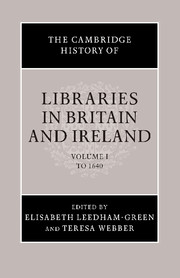Book contents
- Frontmatter
- Introduction
- The physical setting
- Part One The medieval library
- 2 Celtic Britain and Ireland in the early middle ages
- 3 Anglo-Saxon England
- 4 Monastic and cathedral book collections in the late eleventh and twelfth centuries
- 5 The libraries of religious houses in the late middle ages
- 6 College and university book collections and libraries
- 7 Bishops and kings: private book collections in medieval England
- 8 The medieval librarian
- 9 Borrowing and reference: access to libraries in the late middle ages
- Part Two Reformation, dissolution, new learning
- Part Three Tools of the trade
- Part Four Libraries for leisure
- Part Five Organisation and administration
- Select bibliography
- General index
- Index of manuscripts
- References
2 - Celtic Britain and Ireland in the early middle ages
from Part One - The medieval library
Published online by Cambridge University Press: 28 March 2008
- Frontmatter
- Introduction
- The physical setting
- Part One The medieval library
- 2 Celtic Britain and Ireland in the early middle ages
- 3 Anglo-Saxon England
- 4 Monastic and cathedral book collections in the late eleventh and twelfth centuries
- 5 The libraries of religious houses in the late middle ages
- 6 College and university book collections and libraries
- 7 Bishops and kings: private book collections in medieval England
- 8 The medieval librarian
- 9 Borrowing and reference: access to libraries in the late middle ages
- Part Two Reformation, dissolution, new learning
- Part Three Tools of the trade
- Part Four Libraries for leisure
- Part Five Organisation and administration
- Select bibliography
- General index
- Index of manuscripts
- References
Summary
The history of book collections and libraries in the islands of Britain and Ireland begins with Celtic Britain. This area inherited the literary culture of the Roman Empire, while also receiving from the same source in the fourth century the new official religion of Christianity with its book culture centred on the Bible and Christian liturgy. Thus, Celtic Britain had two traditions of literate learning, each with its own type of books: the learning of the late Roman schools with their classical education; and the monastic schools of late antiquity, for whom the highest expression of learning was the study of Scripture. Although no physical evidence for the first type of learning has survived, its existence can be inferred from such British writers as Pelagius and Gildas, both of whom demonstrate in their Latin writings mastery of classical prose style and knowledge of the Roman poets. Both also bear witness to the availability of Christian literature in Celtic Britain, as evidenced by their profound knowledge of the Bible and of Christian writers such as Jerome, Sulpicius Severus and Orosius.
Ireland was never part of the Roman Empire and so did not directly inherit either its classical or Christian learning. Moreover, Ireland’s culture was oral during that period, except for the limited use of a specialised script known as ogam. In the fifth century, Ireland received Christianity and its concomitant literate culture, most likely from British missionaries such as St Patrick. British influence in the formation of Irish Christian culture is evident in the presence of words in Old Irish borrowed from the British vernacular, many of an ecclesiastical character; the formation of a new alphabet for writing Irish based on the Latin alphabet as it was pronounced by British speakers; and the late antique features of Irish manuscript production and script, presumably based upon British models.
- Type
- Chapter
- Information
- Publisher: Cambridge University PressPrint publication year: 2006



